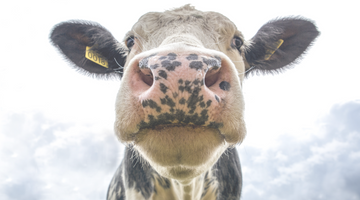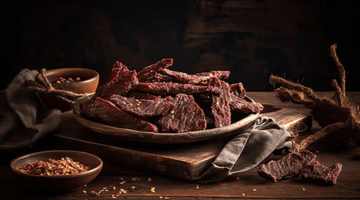
Farmer 1: Why did the beef blush?
Farmer 2: I don’t know, why?
Farmer 1: Because it saw the salad dressing!
Food for Thought!!!
When was the last time you contemplated the journey of the beef on your plate? Or have you paused and pondered the type of beef that typically fills your everyday burger? If your answer is yes, then good for you! However, if the answer is "no," then don't fret because this article is like food for your brain.
As we begin, we will introduce you to grass-fed beef and provide a deeper understanding of the differences between grass-fed and grain-fed beef. We will then discuss why grass-fed beef is a more favorable choice than its grain-fed counterpart.
Additionally, we will examine 12 lesser-known benefits of grass-fed beef. Lastly, we will present you with our top-notch recommendation—3 Lakes Ranch—for your consideration.
What is Grass-Fed Beef?
Grass-fed beef refers to cattle raised on a diet primarily composed of grass, amounting to at least 95% of their feed as they near market weight. This approach results in leaner cattle compared to those fed on grain diets.
The term "grass-fed" is currently being defined by the United States Department of Agriculture (USDA). The USDA's guidelines aim to ensure the accuracy of grass-fed beef labeling, providing consumers with transparent information about the product's origin and composition. This ensures that consumers can confidently choose grass-fed beef, backed by transparent labeling and regulatory standards.

How is Grass-Fed Beef Different from Grain-Fed Beef?
Grass-fed beef differs from grain-fed beef in terms of the animals' diet and resulting characteristics. Grass-fed cattle primarily consume natural grass and forage, leading to leaner meat with a distinct, earthy flavor.
In contrast, grain-fed cattle are raised on a diet of grains, including soy, wheat, and corn, resulting in meat that tends to be higher in fat content. This dietary distinction not only impacts the nutritional composition but also contributes to the flavor profile and overall quality of the beef.
In the below table, we shall examine these differences at length. The table provides a structured and comprehensive analysis of the differences between grass-fed and grain-fed beef.
Grass-Fed Beef Vs. Grain-Fed Beef
|
Grass-Fed Beef |
Grain-Fed Beef |
|
Primarily grazes on natural grass and forage |
Fed with grains, corn, and sometimes soy |
|
Higher in omega-3 fatty acids and antioxidants |
Higher in omega-6 fatty acids and saturated fats |
|
Generally leaner with less marbling |
More marbling, often resulting in more fat content |
|
Often characterized by a distinct grassy flavor |
Tends to have a milder, neutral taste |
|
Deeper red color due to higher antioxidant intake |
Lighter red color due to lower antioxidant intake |
|
Generally, more environmentally friendly |
Can have a larger carbon footprint due to intensive farming |
12 Surprising Health Benefits of Grass-Fed Beef You Can't Afford to Miss!
Now that we have established the core differences between grass-fed and grain-fed beef, we shall in this section discuss in detail, surprising health benefits of Grass-fed beef. We examine the strong arguments for thinking about switching to grass-fed beef here. The advantages of including grass-fed beef in your diet range from its nutrient-rich composition to its favorable effects on heart health, leaner fat profile, and potential environmental benefits. Now let's look more closely at each of these benefits.
- Trimming Fat and Calories: Grass-fed beef slashes fat and calorie content by up to 2/3 compared to feedlot-raised beef. For instance, a 6-ounce grass-finished steak trims down 100 calories versus its grain-fed counterpart. Therefore, it's not just a delectable delight, but a smart step towards a more mindful and balanced eating journey.
- Steering Clear of Antibiotics and Hormones: One of the remarkable aspects of grass-fed beef is that it's a no-go zone for antibiotics and hormones. This means you're savoring meat that's not only delectable but also free from unwanted additives. An interesting twist comes with conjugated linoleic acid (CLA), a beneficial fatty acid found in grass-fed beef. Surprisingly, a notable 37% of individuals who incorporated CLA into their diet experienced an impressive boost in insulin sensitivity. This isn't just about food – it's about empowering your well-being.
- Earthy Flavor Experience: Discovering the world of grass-fed beef is like taking a gastronomical journey. Cows who are contended eat a diverse diet, which results in their distinctive earthy flavor.
- Healthier Fats: When it comes to fats, grass-fed beef takes the lead with its remarkable content of omega-3 fatty acids, surpassing grain-fed alternatives by 2 to 4 times. This beneficial omega 6:3 ratio doesn't just deliver taste; it's a nutritional symphony that resonates with your well-being. So indulge in a flavorful meal that's also an investment in your health.
- Guarding Heart Health: Packed with omega-3s, grass-fed beef aids in managing blood pressure and cardiovascular risks. Omega-3-rich diets are associated with a 50% reduced likelihood of heart attacks.
- Fighting Cancer Naturally: Grass-fed beef emerges as a natural ally in the battle against cancer. Abundant in Conjugated Linoleic Acid (CLA), this meat offers a potent defense against tumor growth. Research points to CLA's promising ability to curtail the proliferation of tumors, showcasing nature's own cancer-fighting potential within the folds of grass-fed beef.

- Reduced Bacterial Risks: By choosing grass-fed beef over conventional options, you drastically decrease the chances of encountering antibiotic-resistant bacteria, thus greatly reducing any potential health risks that may be linked to your meals.
- Elevated Food Safety: A comprehensive study has revealed that a staggering 47% of the tested meat and poultry samples contain S. aureus bacteria. What is even more alarming is that over half of these bacteria (52%) show resistance to at least three different classes of antibiotics. This study marked the inaugural nationwide evaluation of antibiotic-resistant S. aureus within the U.S. food supply.
- Vitamin and Mineral Boost: Grass-fed beef's high micronutrient profile is evident in its B vitamins, vitamin D, and iron content. Its nutritional properties are further enhanced by carotenoids.
- Eco-Friendly Choice: Pasture-raised cows contribute to reducing fossil fuel use and enhancing ecosystem biodiversity. This aligns with the goal of preserving our environment. Meaning, cattle nurtured in open pastures have a lower ecological footprint, consuming fewer fossil fuels compared to their counterparts confined within feedlots. The act of grazing on natural grass not only sustains the cows but also nurtures and enriches the land they roam. This symbiotic relationship promotes enhanced biodiversity within pasture ecosystems and elevates the quality of water runoff.
- Healthier Blood Sugar Levels: Consuming grass-fed beef aids in maintaining healthy blood sugar levels. This benefit is particularly relevant for those embracing a ketogenic lifestyle.
- Transparency and Trust: Grass-fed beef is free of antibiotics and hormones. The integrity of your dietary choices is upheld with data-backed assurance.
What makes 3 Lakes Ranch the best place to order beef?
When choosing the best beef for your table, there's no better place than 3 Lakes Ranch. Since we strongly emphasize establishing an organic and natural way of life for our cattle, you won't find any grain-fed methods used at our Ranch.
Further, we ensure that our cattle are healthy and hygienic to ensure your health. In addition to being farmers, we are also nutritionists. Our passion for proper nutrition ensures our cattle have the best diet, packed with all the right nutrients.
Also, we take the 'bacteria-free' label seriously too. At 3 Lakes Ranch, we've put strict cleanliness and safety procedures in place to ensure that every cut of beef that makes it to your plate is delicious and completely safe to eat.
Frequently Asked Questions
Q. What are the three main benefits of grass fed beef?
A. Grass-fed beef contains lower fat content, more omega-3s, CLA, vitamins, and minerals, all of which may help to promote a diet that is more balanced. Also it contains ample amounts of essential electrolytes like potassium, magnesium, and sodium which helps you maintain a healthy lifestyle.
Q. What are three main health benefits of eating grass-fed beef?
A. The three main health benefits of eating grass-fed beef are:
- Grass-Fed beef helps fight cancer.
- The CLA (conjugated linoleic acid) present in grass-fed beef can decrease your risk of heart disease.
- Eating grass-fed beef can help you maintain healthy blood sugar levels.
Q. Why is it better to eat grass fed meat?
A. Grass-fed beef is often preferred owing to its potential for reduced saturated fat, higher levels of healthy elements like omega-3s and CLA, and ethical concerns surrounding animal care and agricultural methods.
Q. Does grass-fed beef taste different from grain-fed beef?
A. Yes, grass-fed beef is often described as having a more earthy flavor due to the cattle's grass and forage diet. In contrast, grain-fed beef tends to have a milder flavor and may be perceived as juicier and more tender due to the marbling from grain-based diets.




